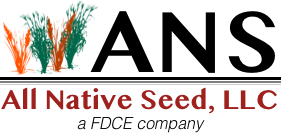
How native grasses provide essential nesting cover, food, and shelter for quail, pheasants, and other upland game birds.
Upland game birds like bobwhite quail, ring-necked pheasants, and wild turkeys are iconic species that have long been valued for their role in recreation, ecological balance, and rural traditions. But in recent decades, their populations have declined due to habitat loss, fragmentation, and land use changes. One of the most effective ways to support these birds is through the establishment of native grasses, a critical habitat component that meets their unique needs.
At All Native Seed (ANS), we specialize in providing high-quality native seed mixes that support upland bird conservation while meeting NRCS standards for programs like the Conservation Reserve Program (CRP). Here’s how native grasses contribute to the health and sustainability of upland game bird populations, and how you can make a difference on your land.
Nesting Cover for Ground-Nesting Birds
Upland game birds rely heavily on native grasses for nesting habitat. Unlike cool-season grasses that become thick and matted, native warm-season grasses like Big Bluestem, Little Bluestem, and Indiangrass form clumps, leaving open space at the ground level. This structure allows hens to build nests and gives chicks room to move safely under cover.
These clump-forming grasses:
- Offer ideal concealment from predators.
- Provide dry, warm nesting sites in early spring.
- Support the survival of newly hatched chicks.
Establishing a well-managed stand of native grasses is one of the most effective ways to boost local quail and pheasant nesting success.
Brood-Rearing Habitat and Food Sources
Once the chicks hatch, they require insect-rich environments to grow. Native grasses paired with native forbs (wildflowers) create diverse habitats that attract a wide variety of insects, pollinators, and soft-bodied prey; the primary food source for young birds.
Forb-rich native plantings:
- Support a high diversity of invertebrates.
- Offer excellent brood cover that’s open at ground level, with overhead protection.
- Encourage movement and foraging for growing chicks.
Including flowering plants like Black-Eyed Susan, Partridge Pea, and Purple Coneflower in your seed mix enhances both the ecological value and the appeal to game birds.
Winter Cover and Shelter from Harsh Weather
During winter months, native grasses continue to offer value. Their tall, dense growth protects birds from snow, wind, and cold temperatures.
Species like:
- Switchgrass (notably robust even in heavy snow)
- Eastern Gamagrass
- Sideoats Grama
…offer excellent thermal protection and roosting areas, helping game birds survive harsh conditions while remaining close to foraging areas.
Why Native Grasses Outperform Non-Natives for Habitat
Many older CRP plantings used non-native species like fescue or bromegrass, which become overly dense and offer little habitat value. In contrast, native warm-season grasses:
- Promote a natural, open-ground structure.
- Are better adapted to regional climates.
- Require less maintenance once established.
- Provide multi-seasonal value to birds and other wildlife.
For landowners and managers aiming to support upland game birds, native grass restoration is one of the most cost-effective and ecologically beneficial tools available.
Partner with All Native Seed for Habitat Success
At ANS, we offer:
- NRCS-compliant CRP seed mixes tailored for upland game bird habitat.
- Expert support to guide your seed selection, site prep, and establishment process.
- Access to professional consultation based on over 400,000 acres of conservation experience.
Whether you’re enrolling in CP2, CP4D, or CP33; Upland Bird Habitat Buffer, our team can help you develop a planting plan that supports biodiversity and benefits game bird populations for generations.
Bring Back the Birds, Start with the Right Seed
By planting native grasses and forbs, you’re not just restoring habitat, you’re restoring a legacy. The right mix can bring back the sights and sounds of upland birds while enhancing the overall health of your land.
Ready to start a habitat project that makes a real impact?
Contact All Native Seed today to explore our seed mix options for game birds and CRP compliance.
